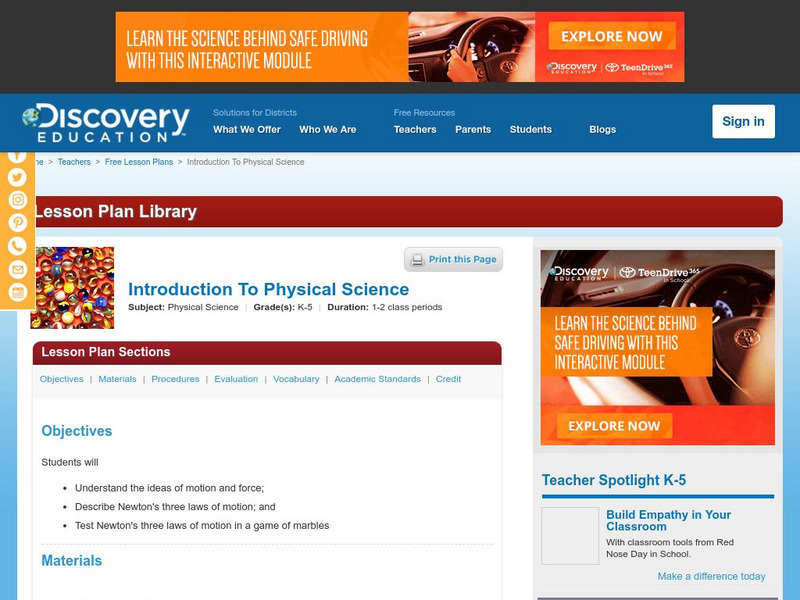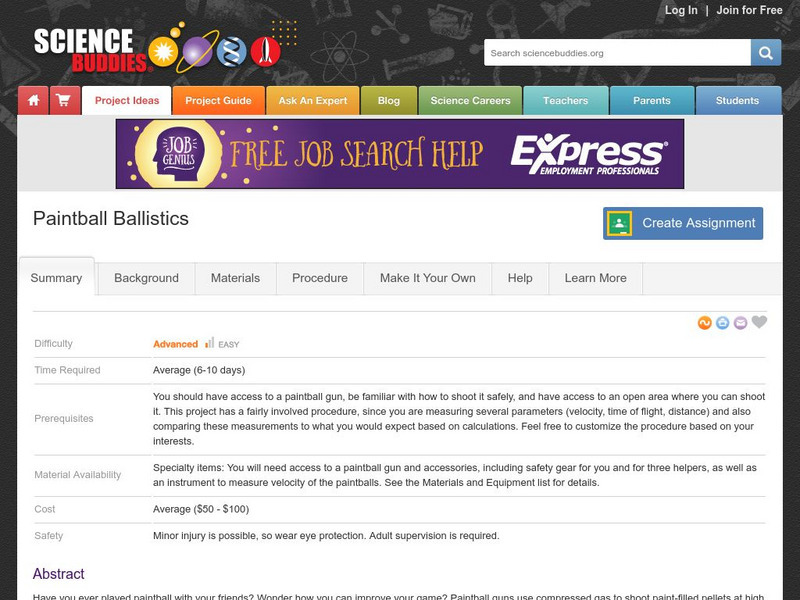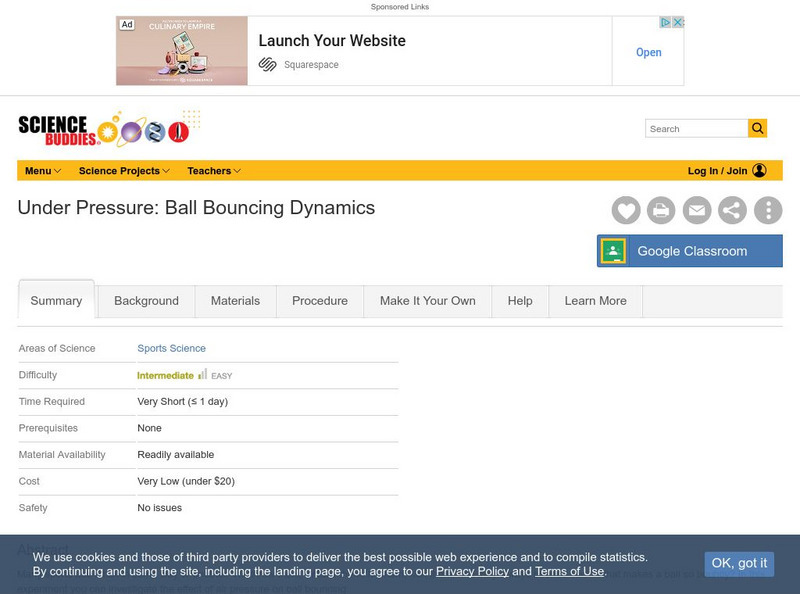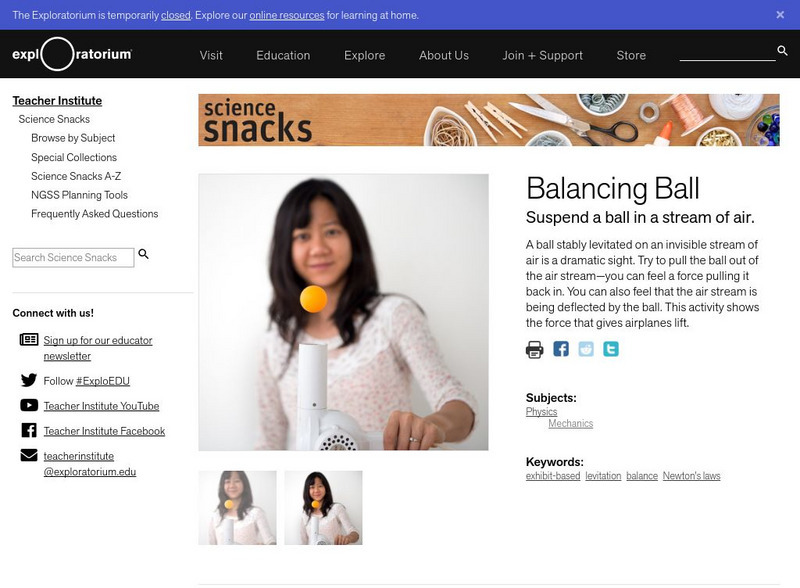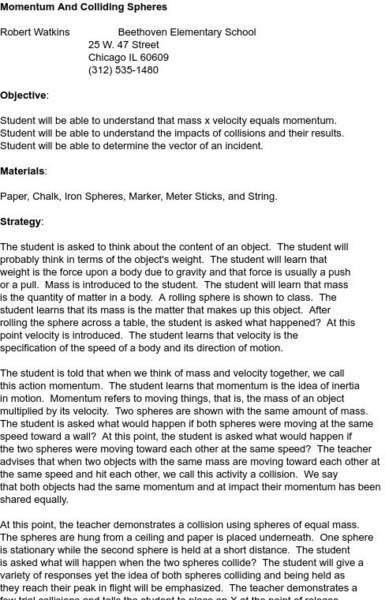Discovery Education
Discovery Education: Introduction to Physical Science
Introduce learners to the ideas of motion and force in this hands-on lesson plan.
Science Buddies
Science Buddies: Swing Low: Investigate the Motion of a Pendulum
Kids love to ride the swings at the playground. The back-and-forth motion of a swing demonstrates the physics of a pendulum. In this experiment, you will investigate the factors that affect the speed and duration of a pendulum's swing.
Other
Bscs: Forces and Motion Content Background Document
In this document, we will try to answer a fundamental question of physical science, "Why do things start to move, slow down, speed up, stop moving or change direction?" In answering these core questions we can develop concepts that can...
Science Buddies
Science Buddies: Centripetal Force
What keeps you in your seat of a giant loop-de-loop roller coaster? Surprisingly, it is not the seatbelt but the seat. It works because of something called centripetal force and it does much more than make a great roller coaster. In this...
Science Struck
Science Struck: A Comprehensive List of All the Physics Formulas
Provides a long list of physics formulas for easy reference.
Science Buddies
Science Buddies: Project Ideas: Paintball Ballistics
In this science fair project, use a paintball gun to compare the calculated vs. the actual range of a projectile. The Science Buddies project ideas are set up consistently beginning with an abstract, objective, and introduction, followed...
Science Buddies
Science Buddies: Under Pressure: Ball Bouncing Dynamics
Many sports use a ball in some way or another. We throw them, dribble them, hit them, kick them, and they always bounce back. What makes a ball so bouncy? In this experiment you can investigate the effect of air pressure on ball bouncing.
TeachEngineering
Teach Engineering: The Science of Swinging
Students learn what a pendulum is and how it works in the context of amusement park rides. While exploring the physics of pendulums, they are also introduced to Newton's first law of motion - about continuous motion and inertia.
Science Buddies
Science Buddies: Roller Coaster Marbles: How Much Height to Loop the Loop?
This is a really fun project even if you don't like going on roller coasters yourself. You'll build a roller coaster track for marbles using foam pipe insulation and masking tape, and see how much of an initial drop is required to get...
Alabama Learning Exchange
Alex: Force and Motion
In this lesson, the young scholars will work across the curriculum using technology, business education, and mathematics. They will form a company and use the physics of force and motion to build a hovercraft. The students will use this...
Science Buddies
Science Buddies: Hey Gear Heads! The Physics of Bicycle Gear Ratios
Here's an abstract of a project from Science Buddies that asks you to experiment with bicycle gears and the circumference of the wheel to determine revolutions per minute.
Ducksters
Ducksters: Physics for Kids: Laws of Motion
Kids learn about the science behind the basic three Laws of Motion. Forces theory discovered by Isaac Newton.
Ducksters
Ducksters: Physics for Kids: Force
Kids learn about force in the science of physics and the laws of motion including units and measurement. How to calculate force from mass and acceleration.
Ducksters
Ducksters: Physics for Kids: Speed and Velocity
Kids learn about speed and velocity in the science of physics and the laws of motion including units and measurement. What is the difference between speed and velocity?
Ducksters
Ducksters: Physics for Kids: Work
Kids learn about work in the science of physics and the laws of motion including units and measurement. Calculate work using force times distance.
Science Struck
Science Struck: 8 Albert Einstein Inventions That Impacted the World
Describes the refrigerator invented by Einstein and many of his discoveries in physics.
Science Struck
Science Struck: The Accomplishments of Isaac Newton
Read about the life of Isaac Newton and his many accomplishments in physics, mathematics, optics, and religious study, and how his discoveries helped in space research.
Science Struck
Science Struck: Understanding the Gyroscopic Effect
Explains what a gyroscope is and the physics behind how it works.
Exploratorium
Exploratorium: Science Snacks: Balancing Ball: Suspend a Ball in a Stream of Air
In this lesson plan students learn about air flow using a suspended ball in an air stream.
Science and Mathematics Initiative for Learning Enhancement (SMILE)
Smile: Colliding Spheres
This lab activity from the Illinois Institute of Technology lets students investigate the impact of collisions upon the velocity and momentum of the colliding objects. Requires understanding of vectors.
Science and Mathematics Initiative for Learning Enhancement (SMILE)
Smile: Objects Race
In this lesson plan grab a slope and different objects. Roll the objects down the slope and record which is the fastest. Learners analyze the features of the objects that make them slow or fast.
